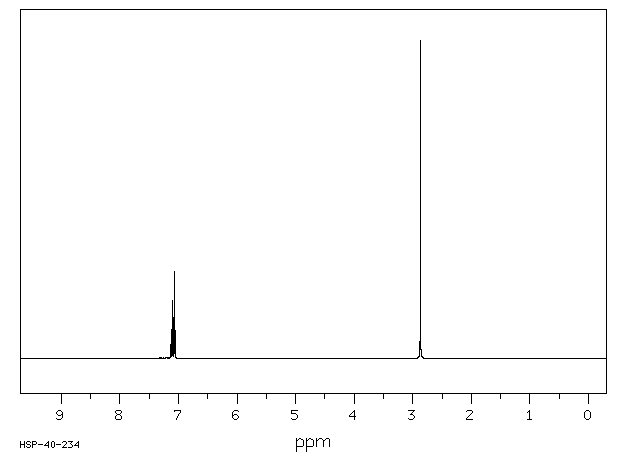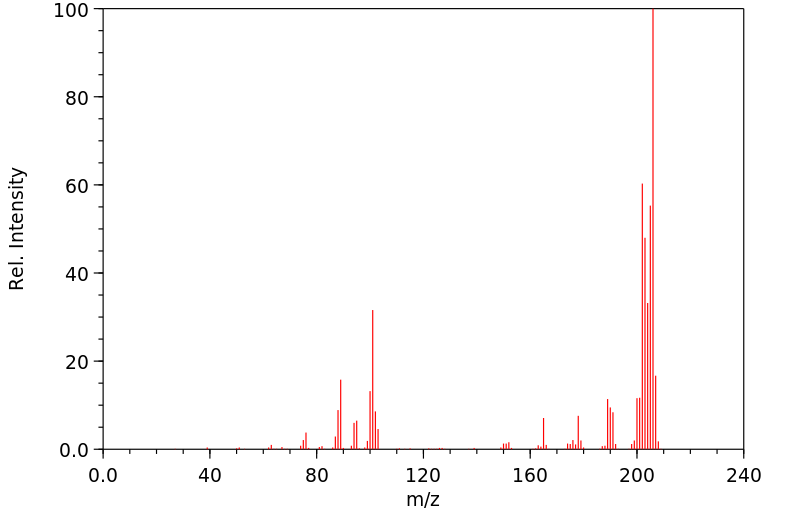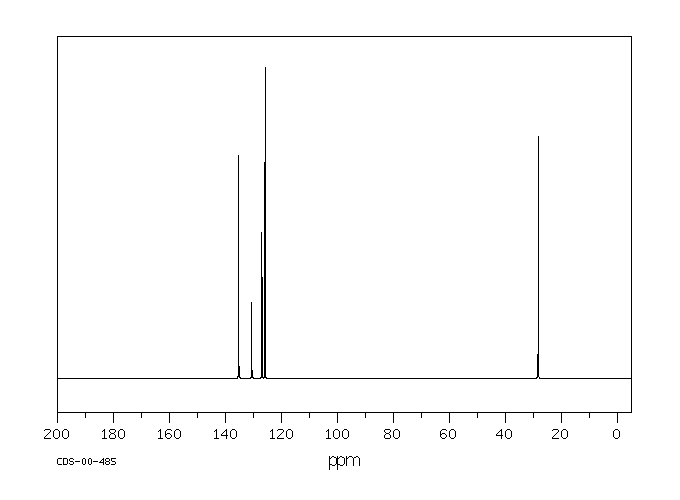4,5,9,10-四氢芘 | 781-17-9
中文名称
4,5,9,10-四氢芘
中文别名
4,5,9,10-四氢苯芘;4,5,9,1-四氢芘
英文名称
4,5,9,10-tetrahydropyrene
英文别名
4,5,9,10-Tetrahydropyren;Tetrahydropyren
CAS
781-17-9
化学式
C16H14
mdl
MFCD00267195
分子量
206.287
InChiKey
XDFUNRTWHPWCKO-UHFFFAOYSA-N
BEILSTEIN
——
EINECS
——
-
物化性质
-
计算性质
-
ADMET
-
安全信息
-
SDS
-
制备方法与用途
-
上下游信息
-
文献信息
-
表征谱图
-
同类化合物
-
相关功能分类
-
相关结构分类
物化性质
-
熔点:138.0 to 142.0 °C
-
沸点:383°C(lit.)
-
密度:1.0426 (estimate)
-
保留指数:329.11;328.95;325.7;325.7;328.26;329.69;329.69
计算性质
-
辛醇/水分配系数(LogP):4.1
-
重原子数:16
-
可旋转键数:0
-
环数:4.0
-
sp3杂化的碳原子比例:0.25
-
拓扑面积:0
-
氢给体数:0
-
氢受体数:0
安全信息
-
海关编码:2902909090
-
危险性防范说明:P261,P280,P301+P312,P302+P352,P305+P351+P338
-
危险性描述:H302,H315,H319,H335
-
储存条件:存放于惰性气体中,避免与空气接触。
SDS
Section I.Chemical Product and Company Identification
Chemical Name 4,5,9,10-Tetrahydropyrene
Portland OR
Synonym Pyrene, 4,5,9,10-tetrahydro- (CA INDEX NAME)
Chemical Formula C16H14
781-17-9
CAS Number
Section II. Composition and Information on Ingredients
Chemical Name CAS Number Percent (%) TLV/PEL Toxicology Data
4,5,9,10-Tetrahydropyrene 781-17-9 Min. 95.0 (GC) Not available. Not available.
Section III. Hazards Identification
No specific information is available in our data base regarding the toxic effects of this material for humans. However,
Acute Health Effects
exposure to any chemical should be kept to a minimum. Skin and eye contact may result in irritation. May be harmful if
inhaled or ingested. Always follow safe industrial hygiene practices and wear proper protective equipment when handling
this compound.
Chronic Health Effects CARCINOGENIC EFFECTS : Not available.
MUTAGENIC EFFECTS : Not available.
TERATOGENIC EFFECTS : Not available.
DEVELOPMENTAL TOXICITY: Not available.
Repeated or prolonged exposure to this compound is not known to aggravate existing medical conditions.
Section IV. First Aid Measures
Check for and remove any contact lenses. In case of contact, immediately flush eyes with plenty of water for at least 15
Eye Contact
minutes. Get medical attention.
In case of contact, immediately flush skin with plenty of water. Remove contaminated clothing and shoes. Wash clothing
Skin Contact
before reuse. Thoroughly clean shoes before reuse. Get medical attention.
If the victim is not breathing, perform mouth-to-mouth resuscitation. Loosen tight clothing such as a collar, tie, belt or
Inhalation
waistband. If breathing is difficult, oxygen can be administered. Seek medical attention if respiration problems do not
improve.
Ingestion INDUCE VOMITING by sticking finger in throat. Lower the head so that the vomit will not reenter the mouth and throat.
Loosen tight clothing such as a collar, tie, belt or waistband. If the victim is not breathing, perform mouth-to-mouth
resuscitation. Examine the lips and mouth to ascertain whether the tissues are damaged, a possible indication that the toxic
material was ingested; the absence of such signs, however, is not conclusive.
Section V. Fire and Explosion Data
Not available.
May be combustible at high temperature. Auto-Ignition
Flammability
Flash Points Flammable Limits Not available.
Not available.
Combustion Products These products are toxic carbon oxides (CO, CO2).
Fire Hazards
Not available.
Risks of explosion of the product in presence of mechanical impact: Not available.
Explosion Hazards
Risks of explosion of the product in presence of static discharge: Not available.
Fire Fighting Media
SMALL FIRE: Use DRY chemical powder.
LARGE FIRE: Use water spray, fog or foam. DO NOT use water jet.
and Instructions
Consult with local fire authorities before attempting large scale fire-fighting operations.
Continued on Next Page
4,5,9,10-Tetrahydropyrene
Section VI. Accidental Release Measures
Spill Cleanup Use a shovel to put the material into a convenient waste disposal container. Finish cleaning the spill by rinsing any
contaminated surfaces with copious amounts of water. Consult federal, state, and/or local authorities for assistance on
Instructions
disposal.
Section VII. Handling and Storage
Handling and Storage Keep away from heat. Mechanical exhaust required. When not in use, tightly seal the container and store in a dry, cool
place. Avoid excessive heat and light. Do not breathe dust.
Information
Always store away from incompatible compounds such as oxidizing agents.
Section VIII. Exposure Controls/Personal Protection
Use process enclosures, local exhaust ventilation, or other engineering controls to keep airborne levels below recommended
Engineering Controls
exposure limits. If user operations generate dust, fume or mist, use ventilation to keep exposure to airborne contaminants
below the exposure limit.
Splash goggles. Lab coat. Dust respirator. Boots. Gloves. Suggested protective clothing might not be sufficient; consult a
Personal Protection
specialist BEFORE handling this product. Be sure to use a MSHA/NIOSH approved respirator or equivalent.
Exposure Limits Not available.
Section IX. Physical and Chemical Properties
Solid. (Powder.) Solubility
Physical state @ 20°C Not available.
Not available.
Specific Gravity
206.28
Molecular Weight Partition Coefficient Not available.
Boiling Point Not available. Vapor Pressure Not applicable.
Not available. Not available.
Melting Point Vapor Density
Not available. Volatility Not available.
Refractive Index
Not available.
Critical Temperature Not available. Odor
Viscosity Not available. Taste Not available.
Section X. Stability and Reactivity Data
Stability
This material is stable if stored under proper conditions. (See Section VII for instructions)
Conditions of Instability Avoid excessive heat and light.
Incompatibilities
Reactive with oxidizing agents.
Section XI. Toxicological Information
Not available.
RTECS Number
Routes of Exposure Eye Contact. Ingestion. Inhalation.
Not available.
Toxicity Data
Chronic Toxic Effects CARCINOGENIC EFFECTS : Not available.
MUTAGENIC EFFECTS : Not available.
TERATOGENIC EFFECTS : Not available.
DEVELOPMENTAL TOXICITY: Not available.
Repeated or prolonged exposure to this compound is not known to aggravate existing medical conditions.
Acute Toxic Effects No specific information is available in our data base regarding the toxic effects of this material for humans. However,
exposure to any chemical should be kept to a minimum. Skin and eye contact may result in irritation. May be harmful if
inhaled or ingested. Always follow safe industrial hygiene practices and wear proper protective equipment when handling this
compound.
Section XII. Ecological Information
Not available.
Ecotoxicity
Not available.
Environmental Fate
Continued on Next Page
4,5,9,10-Tetrahydropyrene
Section XIII. Disposal Considerations
Waste Disposal Recycle to process, if possible. Consult your local regional authorities. You may be able to dissolve or mix material with a
combustible solvent and burn in a chemical incinerator equipped with an afterburner and scrubber system. Observe all
federal, state and local regulations when disposing of the substance.
Section XIV. Transport Information
Not a DOT controlled material (United States).
DOT Classification
PIN Number Not applicable.
Proper Shipping Name Not applicable.
Packing Group (PG) Not applicable.
DOT Pictograms
Section XV. Other Regulatory Information and Pictograms
TSCA Chemical Inventory This product is NOT on the EPA Toxic Substances Control Act (TSCA) inventory. The following notices are required by 40
CFR 720.36 (C) for those products not on the inventory list:
(EPA)
(i) These products are supplied solely for use in research and development by or under the supervision of a technically
qualified individual as defined in 40 CFR 720.0 et sec.
(ii) The health risks of these products have not been fully determined. Any information that is or becomes available will be
supplied on an MSDS sheet.
WHMIS Classification Not available.
(Canada)
EINECS Number (EEC) Not available.
EEC Risk Statements Not available.
SECTION 16 - ADDITIONAL INFORMATION
N/A
上下游信息
-
上游原料
中文名称 英文名称 CAS号 化学式 分子量 —— 2-amino-4,5,9,10-tetrahydropyrene 101283-00-5 C16H15N 221.302 2-硝基-4,5,9,10-四氢芘 2-nitro-4,5,9,10-tetrahydropyrene 10549-22-1 C16H13NO2 251.285 -
下游产品
中文名称 英文名称 CAS号 化学式 分子量 —— 2,7-di-n-hexyl-4,5,9,10-tetrahydropyrene 837421-20-2 C28H38 374.61 —— 2-hydroxy-4,5,9,10-tetrahydropyrene 117684-99-8 C16H14O 222.287 2,7-二溴-4,5,9,10-四氢-芘 2,7-dibromo-4,5,9,10-tetrahydropyrene 17533-36-7 C16H12Br2 364.079 —— 2-bromo-4,5,9,10-tetrahydropyrene 10549-27-6 C16H13Br 285.183 —— 2-amino-4,5,9,10-tetrahydropyrene 101283-00-5 C16H15N 221.302 —— 2-acetyl-4,5,9,10-tetrahydropyrene 82799-67-5 C18H16O 248.324 —— 2,7-diacetyl-4,5,9,10-tetrahydropyrene 86470-98-6 C20H18O2 290.362 —— 2,7-bis(4-methoxyphenyl)tetrahydropyrene 136613-08-6 C30H26O2 418.535 —— 4,5,9,10-tetrahydropyrene-2-carboxylic acid 180623-88-5 C17H14O2 250.297 —— 2,7-di-n-hexanoyl-4,5,9,10-tetrahydropyrene 837421-19-9 C28H34O2 402.577 —— Ethyl 4,5,9,10-tetrahydropyrene-2-carboxylate 180623-83-0 C19H18O2 278.351 2-硝基-4,5,9,10-四氢芘 2-nitro-4,5,9,10-tetrahydropyrene 10549-22-1 C16H13NO2 251.285 4,5,9,10-四氢-2,7-二硝基-芘 2,7-dinitro-4,5,9,10-tetrahydropyrene 117929-13-2 C16H12N2O4 296.282 —— 2-bromo-4,5,9,10-tetrahydro-7-pyrenecarboxylic acid octyl ester 916049-07-5 C25H29BrO2 441.408 —— Ethyl 7-nitro-4,5,9,10-tetrahydropyrene-2-carboxylate 180623-84-1 C19H17NO4 323.348 - 1
- 2
反应信息
-
作为反应物:描述:参考文献:名称:557.有机反应中的氢化物离子。第一部分:高氯酸三苯甲酯脱氢摘要:DOI:10.1039/jr9590002773
-
作为产物:描述:芘 在 四氢呋喃 、 甲基溴化镁 、 氢气 、 cobalt acetylacetonate 、 1,3-双(2,6-二异丙基苯基)氯化咪唑鎓 作用下, 60.0 ℃ 、8.0 MPa 条件下, 反应 48.0h, 以61%的产率得到4,5,9,10-四氢芘参考文献:名称:多环芳烃的铬和钴催化区域控制加氢:一项联合实验和理论研究摘要:由于芳香性引起的热力学稳定性,多环芳烃是难以加氢的底物。我们在这里报告了在环境温度下多环芳烃的第一个铬和钴催化的区域控制加氢。这些反应由低成本的铬或钴盐与二亚氨基/卡宾配体和甲基溴化镁结合促进,具有高区域选择性和扩大的底物范围,包括并四苯、四苯、并五苯和苝,它们很少被还原。该方法提供了一种具有成本效益的氢化催化方案,具有可扩展性,可用于通过氢化产物的功能化合成四溴和羧基取代的基序。DOI:10.1021/jacs.9b03328
文献信息
-
Metallic Barium: A Versatile and Efficient Hydrogenation Catalyst作者:Philipp Stegner、Christian Färber、Ulrich Zenneck、Christian Knüpfer、Jonathan Eyselein、Michael Wiesinger、Sjoerd HarderDOI:10.1002/anie.202014326日期:2021.2.19catalysis tops that of the hitherto most active molecular group 2 metal catalysts. Depending on the substrate, two different catalytic cycles are proposed. A: a classical metal hydride cycle and B: the Ba metal cycle. The latter is proposed for substrates that are easily reduced by Ba0, that is, conjugated alkenes, alkynes, annulated rings, imines and pyridines. In addition, a mechanism in which Ba0 and BaH2
-
Molecular Compasses and Gyroscopes. II. Synthesis and Characterization of Molecular Rotors with Axially Substituted Bis[2-(9-triptycyl)ethynyl]arenes作者:Carlos E. Godinez、Gerardo Zepeda、Miguel A. Garcia-GaribayDOI:10.1021/ja012550i日期:2002.5.1We have developed a simple convergent procedure for the synthesis of molecular rotors consisting of a central aromatic group coupled with two axially positioned ethynyltriptycenes. Molecular rotors with 1,4-phenylene (1), 1,4'-1,1'-biphenylene (2), 9,10-anthracenylene (3), and 2,7-pyrenylene (4) groups were prepared by Pd(0)-catalyzed coupling of ethynyl triptycenes with the corresponding dibromoarenes我们开发了一种简单的收敛程序,用于合成由一个中心芳香基团和两个轴向定位的 ethynyltriptycenes 组成的分子转子。通过 Pd 制备了具有 1,4-亚苯基 (1)、1,4'-1,1'-亚联苯基 (2)、9,10-蒽 (3) 和 2,7-芘 (4) 基团的分子转子(0)-催化的乙炔基三苯乙烯与相应的二溴芳烃偶联。虽然预计化合物 1-4 在固态下不会有自由旋转,但通过半经验方法分析了 1 和 3 的旋转势,并分析了 1 的晶体堆积以设计最有可能产生功能性转子的结构。固体状态。半经验 PM3 计算预测化合物 1、2 和 4 即使在低至 25 K 的温度下也具有无摩擦的内部旋转,而预期化合物 3 的屏障为约。4 大卡/摩尔。
-
Quenched skeletal Ni as the effective catalyst for selective partial hydrogenation of polycyclic aromatic hydrocarbons作者:Chengyun Liu、Zeming Rong、Zhuohua Sun、Yong Wang、Wenqiang Du、Yue Wang、Lianhai LuDOI:10.1039/c3ra44871a日期:——Quenched skeletal Ni is an active and selective catalyst for selective partial hydrogenation of polycyclic aromatic hydrocarbons (PAHs). The molecular structure of PAHs significantly dominate the hydrogenation process and furthermore, the distribution of hydrogenated products.淬灭的骨架Ni是一种用于多环芳烃(PAHs)选择性部分加氢的活性和选择性催化剂。PAHs的分子结构显着支配了氢化过程,此外还决定了氢化产物的分布。
-
Ligand-enabled and magnesium-activated hydrogenation with earth-abundant cobalt catalysts作者:Bo Han、Miaomiao Zhang、Hongmei Jiao、Haojie Ma、Jijiang Wang、Yuqi ZhangDOI:10.1039/d1ra07266h日期:——Pd, Ir, Ru, and Rh with inexpensive earth-abundant metals like cobalt (Co) is attracting wider research interest in catalysis. Cobalt catalysts are now undergoing a renaissance in hydrogenation reactions. Herein, we describe a hydrogenation method for polycyclic aromatic hydrocarbons (PAHs) and olefins with a magnesium-activated earth-abundant Co catalyst. When diketimine was used as a ligand, simple用廉价的地球丰富的金属如钴 (Co) 代替昂贵的贵金属如 Pt、Pd、Ir、Ru 和 Rh,正在吸引更广泛的催化研究兴趣。钴催化剂现在正经历加氢反应的复兴。在此,我们描述了一种使用镁活化的富含地球的 Co 催化剂对多环芳烃 (PAHs) 和烯烃进行加氢的方法。当二酮亚胺用作配体时,CoBr 2的简单且廉价的金属盐与镁结合在温和条件下对具有挑战性的多环芳烃进行位点选择性加氢显示出高催化活性。共催化氢化能够减少多环芳烃的两侧芳烃。多种多环芳烃可以以位点选择性方式进行氢化,这为制备部分还原的多环烃基序提供了一种经济、清洁和选择性的策略,而这些多环烃基序很难通过常规方法制备。还证明了使用定义明确的二酮亚胺配体 Co 配合物作为多环芳烃和烯烃选择性加氢的预催化剂。
-
Structural, Mechanistic, Spectroscopic, and Preparative Studies on the <i>Lewis</i> Base Catalyzed, Enantioselective Sulfenofunctionalization of Alkenes作者:Eduard Hartmann、Scott E. DenmarkDOI:10.1002/hlca.201700158日期:2017.9with the spectroscopic identification of putative thiiranium ion intermediates generated in the enantiodetermining step. The structural insights gleaned from these studies informed the design of new catalyst architectures to improve enantioselectivity. In addition, structural modification of the sulfenylating agents had a significant and salutary effect on the enantioselectivity of sulfenofunctionalization
表征谱图
-
氢谱1HNMR
-
质谱MS
-
碳谱13CNMR
-
红外IR
-
拉曼Raman
-
峰位数据
-
峰位匹配
-
表征信息
同类化合物
(R)-2,2'',3,3''-四氢-6,6''-二-9-菲基-1,1''-螺双[1H-茚]-7,7''-二醇
(6,6)-苯基-C61己酸甲酯
高雌二醇
马兜铃酸钠
马兜铃酸盐
马兜铃酸C
马兜铃酸B
马兜铃酸(1:1MIXTUREOFARISTOLOCHICACIDIANDARISTOLOCHICACIDII)
马兜铃酸 Ia
马兜铃酸 IVa
马兜铃酸
颜料黑32
颜料红179
颜料红178
颜料红149
颜料红123
顺式-菲-1,2-二醇-3,4-环氧化物
顺式-苯并(a)屈-11,12-二醇-13,14-环氧化物
雷公藤酚A
镁二(1,4,5,6,7,16,17,18,19,19,20,20-十二氯六环[14.2.1.14,7.02,15.03,8.09,14]二十-5,9,11,13,17-五烯-11-磺酸酯)
钩大青酮
钩大青酮
钙(2+)12-羟基十八烷酸酯
酒石酸布托诺啡
那布扶林
还原红32
足球烯
贝那他汀B
贝母兰素
萘并[2,3-b]荧蒽
萘并[2,1-e][1]苯并二硫杂环戊烷
萘并[2,1-C:7,8-C']二菲
萘并[1,2-e][2]苯并呋喃-1,3-二酮
萘并[1,2-b]屈
萘并[1,2-a]蒽
萘并[1,2-B]菲-6-醇
萘二(六氯环戊二烯)加合物
萘,8-溴-1,2,3-三(1,1-二甲基乙基)-6-甲基-
菲醌单缩氨基硫脲
菲醌
菲并[9,10]呋喃
菲并[9,10-e]醋菲烯
菲并[4,5-bcd]噻吩
菲并[4,5-bcd]呋喃-3-醇
菲并[4,3-d]-1,3-二噁唑-5-羧酸,10-羟基-9-甲氧基-6-硝基-
菲并[3,2-b]噻吩
菲并[2,1-d]噻唑
菲并[2'',1'',10'':4,5,6;7'',8'',9'':4',5',6']二异喹啉并[2,1-a:2',1'-a']二萘嵌间二氮杂苯-8,13-二酮
菲并(3,4-b)噻吩
菲并(1,2-b)噻吩










